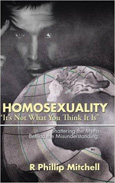
 |
This ninety-page thesis, including works cited, begins with a dedication, preference, and introduction. It then steps into thirty terse essays regarding "Shattering the Myths Behind the Misunderstanding” or an "intense study and forensic look into human sexuality, and its effects on us all."
The book's initial chapters concern the first modern trial regarding sodomy, an early definition of homosexuality, homosexuality in Africa, and the sexual practices of early Grecians. Various stories of pedophilia, homosexuality, androgyny, inter-sex persons, childhood sexual play, and gender variations are utilized to explore a general study of "alternative lifestyles.” Topics include true confessions, essential components of a healthy relationship, androgyny, and joy and pain. Other writings explore issues such as my dad is now a woman, can I be a gay Christian, was King James a homosexual, and faith.
The book's best work is regarding patience, persistence, purpose, and success. The most accurate and well-written chapter is on the "Four Essential Components of a Healthy, Nontoxic Relationship," with a belief system of love, honesty, respect, and trust. According to the author, this needs to be in a heterosexual relationship, but it reveals the essence of any successful intimate relationship, which is also seen repeated in non-heterosexual relationships including friendships and certain business relationships.
"At the crux of the homosexual debate is the scientific fact that every man, woman, boy, and girl was born out of an intimate, monogamous, relationship between a male and a female," states Mitchell. This is an undeniable biological fact, but it speaks nothing of the individual personalities that are by-products of the merger of a man and woman. The book does not address children conceived in sexual heterosexual hook-ups, non-monogamous relationships, or violence such as rape. Nor does it explain how loving and morally centered heterosexual relationships give birth to GLBT children.
A "forensic look" is a scientific term, which assumes that the entire spectrum of events is taken into consideration, otherwise the sample is considered skewed. Mitchell seems to ignore the many studies indicating that sexual orientation (including fluidity of sexuality) becomes fixed between ages three and five, which does not support many of the theories presented in these pages. The author appears to support the homosexuality as character flaw or deviance theory.
One significant misconception throughout the book involves the assumption that pedophilia is homosexuality. Pedophilia is having sexual attractions and/or sex with children (either sex) by adults and is a psychiatric illness. Homosexuality is being attracted to someone of the same sex on the levels of emotional, physical, intellectual, and spiritual connections. Homosexuality is not a psychiatric illness by current standards, nor is it considered a predatory crime like pedophilia. Furthermore, there is no factual study that supports incest as a cause of homosexuality or alternative lifestyles. Also, studies indicate there is no correlation between knowing someone who is GLBTQ and becoming gay themselves.
Mitchell's faith-based views will appeal to those who have the same belief system as a fundamentalist Christian minister or those who view homosexuality as a mental disorder. Much of the book's research is based on The National Association of Research and Therapy of Homosexuality, which is known in the scientific community for its misconceptions and for its belief that sexuality can be changed. This group promotes conversion/reparative therapy, which has been deemed unethical and harmful by major medical, psychological, and social work groups.